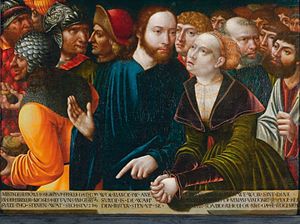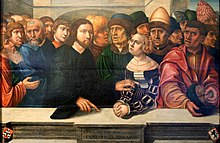Christ and the Adulteress (Hans Kemmer)

|
| Christ and the adulteress |
|---|
| Hans Kemmer , around 1535 |
| oil on wood |
| 50.5 × 61.5 cm |
| St. Anne's Museum Lübeck Inv.No. 2010/118 |
Christ and the Adulteress is a painting by the German painter Hans Kemmer .
motive
Shown is the passage about Jesus and the adulteress ( John 8: 1–11 LUT ), which describes how Jesus contradicts the scribes ' demands to stone a newly convicted adulteress and instead demonstratively exercises forgiveness. At the lower edge there is a painted parapet, which contains part of the associated Bible text in Middle Low German , behind it stands the group of people from Jesus, the adulteress, and the disciples on the right and the accusers on the left.
The motif was particularly popular in the years after the Reformation , as it symbolizes the Lutheran doctrine of justification by grace alone . Several versions of this theme have survived from Kemmer's teacher Lucas Cranach the Elder .
The picture
Kemmer's painting was created in Lübeck soon after the Reformation was accepted in 1530/31 and is to be understood as a Protestant doctrine that shows that the forgiveness of their sins is open to all people. In a typical way, the picture is linked to a didactically explanatory text to which the hand of Christ points.
In the 19th century, for reasons that were not clearly clear, the picture was subsequently extended upwards with an attached bar; In order to optically integrate the empty dark surface into the original image, one of the accusers' turban was enlarged disproportionately so that it protrudes into the otherwise empty upper edge. This attachment was not removed during the restoration, as it is now a historical element in itself. It was only covered by the new frame so that the viewer can see the painting in its original composition and proportions.
Provenance
The picture can be verified for the first time in the 18th century in the possession of the Princes of Carolath-Beuthen . From the early 19th century it was owned by the Silesian line of the Counts of Pückler , and later in a private collection in London.
In November 2010 the painting was bought by the City of Lübeck at an auction of the Kunsthaus Lempertz for 42,000 euros (50,400 euros including buyer's premium ) and included in the holdings of the St. Anne's Museum . In 2011 it was completely restored, also addressing the negative effects of an older protective coating.
It has been on display in the St. Anne's Museum since spring 2012. The Lübeck Museum now has a third of Kemmer's well-known works, including Kemmer's earlier version Christ and the Adulteress from 1530, a work commissioned by the merchant Johann Wigerinck .
Versions
Kemmer has also received two further adaptations of the same motif: The commissioned work for Johann Wigerinck from 1530 mentioned above bears the coats of arms of the client and his wife Agnete Kerckring. Here, too, are the words of the Bible in Low German on a balustrade in front of the characters. The accusers are shown here on the right and the disciples on the left of Jesus and the woman. In the disciple behind Jesus, the founder may be portrayed, who had had himself painted by Kemmer together with his wife the year before. In the middle under the sentence "Wol manck iu ane Sunde is de warp den irsten Sten up se" (= "Who of you is without sin, throw the stone at you") the painter has signed HK. The picture was acquired in 1910 from the auction of the Schwartz private collection in Berlin for the Lübeck Museum.
In addition, a picture that was auctioned at Christie's in 2000 is attributed to Kemmer by Kurt Lochs and Dieter Koepplin . In front of the people there is also a balustrade on which Jesus writes TERRA TERRAM ACCUSAT (= the earth accuses the earth) - to be read by the observer overhead . This phrase is found in medieval miniatures such as B. in Codex Egberti and probably goes back to a homily by Augustine von Hippo .
swell
- Liliane Jolitz: Tender operation on an adulteress. In: Lübecker Nachrichten , May 20, 2011
- Thorsten Rodiek : Hans Kemmer - Christ and the adulteress. A new acquisition by the St. Anne's Museum. In Lübeckische Blätter 177 (2012), No. 7, pp. 110–113 digitized version (PDF; 4.6 MB)
- Friedricke Schütt: Christ and the Adulteress [1535] in: Jan Friedrich Richter (Hrsg.): Lübeck 1500 - Art metropolis in the Baltic Sea region , catalog, Imhoff, Petersberg 2015, pp. 358–359 (No. 67)
Individual evidence
- ↑ a b Lempertz.com , accessed on April 22, 2018
- ↑ Rodiek (lit.), p. 110
- ↑ Inv. No. 1921/84; Friedricke Schütt: Christ and the Adulteress [1530] in: Jan Friedrich Richter (Hrsg.): Lübeck 1500 - Art metropolis in the Baltic Sea region , catalog, Imhoff, Petersberg 2015, pp. 356–357 (No. 66)
- ^ Rita Kauder: The three Protestant religious pictures by Hans Kemmer in the Museum for Art and Cultural History of the Hanseatic City of Lübeck . In: ZLGAG 62, 1982, pp. 83-101; P. 89.
- ↑ [1]
- ↑ Augustine of Hippo: Sermo 13, 4


